Achieving a Resource-Efficient Society
- Efforts to Achieve a Resource-Efficient Society
- Approach to Transitioning to a Circular Economy
- Management of Waste and Valuables Generated at Business Sites
- Management of Water Use at Business Sites
- Products and Services that Contribute to Resolving Water Issues
Efforts to Achieve a Resource-Efficient Society
Approach & Policy
Environmental issues continue to intensify associated with increased economic and social activities within the conventional linear economy of mass production, mass consumption, and mass disposal. These problems involve resource shortages, water scarcity, tight supply and demand for energy, environmental pollution caused by increasing waste, global warming, and the loss of biodiversity.
To solve these problems and create sustainable societies, we must shift away from linear economies to circular economies. Hitachi works together with customers and society to help build a society that uses water and other resources efficiently.
Initiatives in the Value Chain
Hitachi considers the circularity of resources across the value chain to be of key importance. We also believe in the importance of water usage reduction that takes into consideration water risks on a region-by-region basis at each stage of the supply chain. Accordingly, we drive circular-design initiatives and development tools, applications, and services that help facilitate circular economies, optimize water usage and wastewater treatment in the supply chain, and provide water-efficient products and services.
Initiatives at Business Sites
We established a long-term environmental target to improve the efficiency with which water and other resources are used by fiscal 2050. The actual goal is to improve efficiency by 50% compared to fiscal 2010. In addition, we will create higher economic value using fewer resources while pursuing production activities with a lower environmental burden.
Initiatives to Achieve a Resource-Efficient Society
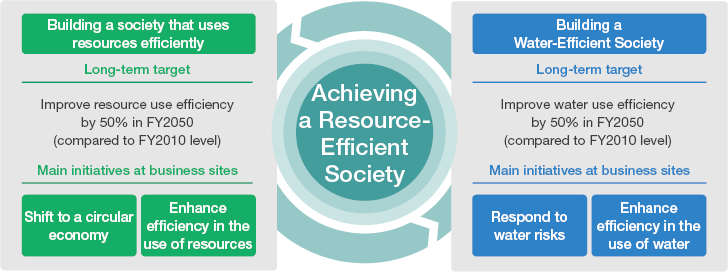
Our response to water risks that take biodiversity into consideration are detailed in Efforts to Achieve a Society Harmonized With Nature
Efforts to Achieve a Harmonized Society with NatureApproach to Transitioning to a Circular Economy
Approach & Policy
To help build a society that uses resources efficiently, Hitachi will advance a shift from the conventional linear economy to a circular economy. Therefore, we will focus on how we can continue to use resources and assets in our business activities and reduce waste, or even eliminate waste altogether, using three approaches: innovation in upstream product design, innovation in the product manufacturing process, and innovation of our business model.
(1) Innovation in Product Design
Through Environmentally Conscious Design Assessments and Life Cycle Assessments for new products that involve design activities, we will reduce waste by standardizing parts, extending service life, utilizing recycled materials, and designing for easy recyclability. To this end, we revised the Hitachi Eco Design Management Guidelines and Hitachi Eco Design Activity Guidelines to reflect the latest international trends. At the same time, we set a clear goal to apply the relevant assessments to all new products involving design activities and to achieve this goal by fiscal 2024.
(2) Innovation in the Manufacturing Process
We share case studies among divisions to highlight initiatives in this area. Case studies include product and parts manufacturing volume optimization based on an understanding of supply and demand, digitization of design processes for paperless work, the reduction of packaging material usage, the reduction of defective products through quality improvement, and the reduction of chemical substances. Further, we established specific targets for the number of sites achieving the goal of the Zero Waste to Landfill initiative, as well as for effective utilization rates related to plastic waste. In particular, we initiated activities targeting all manufacturing sites from fiscal 2022 with the aim of achieving Zero Waste to Landfill*1.
*1Pursued in careful compliance with regulations, conditions, etc., in each country or region
(3) Innovation of Business Model
To adapt to a society that is transitioning from goods to experiences, or in other words, from ownership to leasing, we pursue the effective use of resources and assets through leasing, pay-per-use systems, subscriptions, products as a service, reuse, and sharing-based models. At the same time, we collect used products and consider their sale, repair, or recycling, making continuous efforts to devise strategies for the most efficient utilization of resources and assets. To this end, we share our goals with various stakeholders in the value chain and pursue collaborative creation. Additionally, we pursue research and development involving raw materials, products, tools, applications, and services necessary for our goals, leveraging the advantages of Hitachi’s IT × Operational Technology (OT) × Products to support the creation of circular economies not only in our value chain, but in customer activities as well.
Improving the Environmental Performance of Products and Services Through Eco-DesignApproach to Transitioning to a Circular Economy
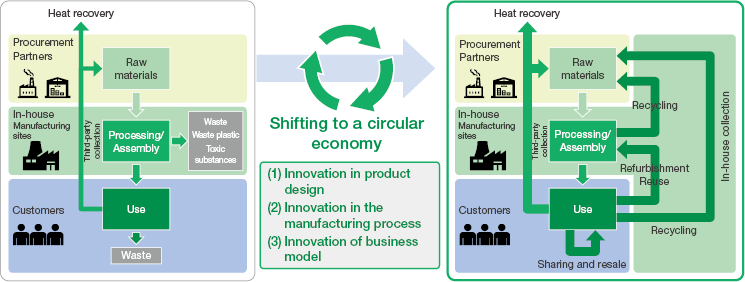
Note:Hitachi normally refers to suppliers (including vendors and providers) as procurement partners, with whom we build business together on an equal footing.
Management of Waste and Valuables Generated at Business Sites
Activities
We collect environmental load data for waste and valuables*1 generated at the business sites to centrally manage the volumes of waste and valuables generated and exported by type. For hazardous waste, in particular, we ensure thorough compliance with laws and regulations, and engage in proper disposal within the group.
To streamline our data collection operations, we started transitioning from the previous Environmental Data Collection System (Eco-DS) to the ESG Management Support Service (ESG-MSS) in fiscal 2023. We plan to complete this transition in fiscal 2024.
For fiscal 2023, the midpoint of the Environmental Action Plan for 2024 (fiscal 2022–2024), we established a 17% per-unit reduction target (compared with a base year of fiscal 2010) for waste and valuables generated. We were unable to meet this target, but were able to reduce it by 15%.
The reasons for not meeting the target were due to an increase in waste from packaging materials used during transportation, resulting from a rise in international orders, and the exclusion of the reduction rate in waste and valuables generation per unit for auto parts-related companies due to deconsolidation.
We reduced the amount of waste and valuables generated by 21kt, or 13%, compared to the base year. We accomplished this result through ongoing measures such as installing recycling facilities within our business sites and closed-loop recycling, whereby byproducts and scrap from the production process are reused as resources by other business sites, while packing and cushioning materials for transportation are used repeatedly.
*1Waste and valuables: Materials generated through business activities. Each country has a legal definition of waste, and in Japan, the term refers to refuse, bulky refuse, ashes, sludge, excreta, waste oil, waste acid and alkali, carcasses, and other filthy and unnecessary matter, which are in a solid or liquid state according to the Waste Management and Public Cleansing Law. Valuables, meanwhile, are those materials left over after business activities other than waste, and that can be sold or transferred free of charge to other parties as items of value.
Environmental Action Plan for 2024 Management Values
Reduction Rate in Waste and Valuables Generation*1 per Unit (Hitachi Group)
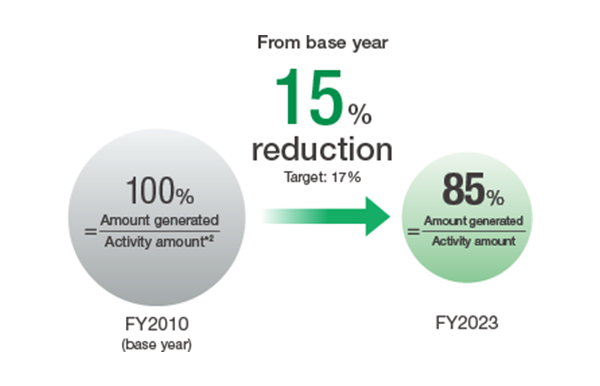
*1Amount of waste and valuables generated from the production process.
*2Activity amount is a value closely related to waste and valuables generation at
each business site (for example, output, sales, and production weight).
Waste and Valuables Generation*1 (Hitachi Group)
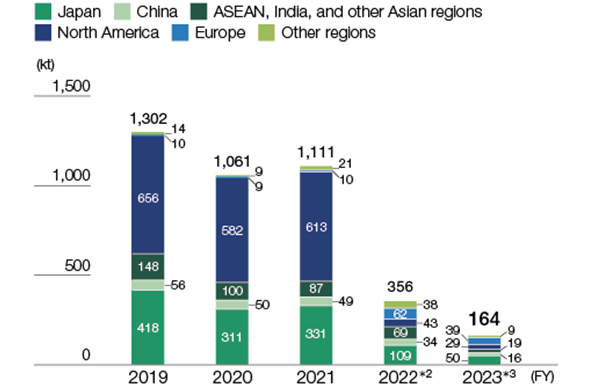
*1Waste and valuables: Through fiscal 2021, this volume was the amount of waste and valuables generated by major business sites. Beginning in fiscal 2022, this volume is the total amount of waste and valuables generated in the manufacturing processes of all business sites and the amount generated at offices other than manufacturing processes.
*2In fiscal 2022, the report above includes waste and valuables generated by an energy-related company and auto parts-related companies in fiscal 2022. Significant decrease due to deconsolidation of materials-related and construction machinery-related companies.
*3In fiscal 2023, the amount decreased due to the deconsolidation of the auto parts-related companies.
Number of Sites Achieving the Goal of the Zero Waste to Landfill Initiative
Materiality
We pursue activities to achieve the goals of the Zero Waste to Landfill*1 initiative, which seeks to minimize landfill disposal for the ongoing, sustainable utilization of resources. We have set specific targets for the number of manufacturing sites to achieve zero landfill waste, and we are stepping up efforts to accelerate this initiative. In fiscal 2023, 146 of the sites covered by our activities achieved zero landfill waste.
Environmental Action Plan for 2024 Management Values
FY2023 target: 124 business sites (approx. 34%)
Note: All manufacturing sites are covered
*1Zero Waste to Landfill goal: Defined as a final disposal rate (landfill disposal/ waste and valuables) of less than 0.5% in any given fiscal year in the Hitachi Group. Pursued in assumed conformance with regulations, conditions, etc.
Effective Utilization Rate of Plastic Waste
We began strengthening our activities in fiscal 2022 toward achieving a 100% effective utilization*1 rate of waste plastics throughout the entire Hitachi Group by fiscal 2030. In fiscal 2023, we set an effective utilization rate target of 81% and achieved 96%. To improve the effective utilization rate, we are implementing measures that include design changes for equipment and products that do not generate waste, reduction of waste through yield improvements, in-house reuse, sorting and accumulation of waste to enhance value, and recycling measures through detailed sorting.
Hitachi Global Life Solutions, whose plastic consumption accounts for around 70% of the Hitachi Group’s total, uses recycled plastic in parts for washing machines and refrigerators and packing materials for ceiling lights. The company procures recycled plastic materials produced within the Hitachi Group, such as plastic parts recovered from end-of-life home appliances and plastic containers, and also uses recycled plastics sourced from other materials manufacturers.
While large components in washing machines (enclosure bases in the lower parts of units, etc.) were previously made using a mixture of new and recycled materials, the company shifted to almost 100% recycled plastics, achieved by solving technical problems and procurement issues.
To facilitate recycling of home appliances in Japan, Hitachi Global Life Solutions works to recycle four categories of end-of-life home appliances (air conditioners, TVs, refrigerators/freezers, and washing machines/dryers) at 19 recycling plants as part of cooperative efforts among five companies*2 in response to the 2001 Act on Recycling of Specified Home Appliances. A total of 67.0kt of recyclable materials*3 were recovered in fiscal 2023, of which approximately 59.4kt were recycled. By product type, the recycling rate for refrigerators and freezers was 80%, exceeding the legal requirement of 70% by 10 percentage points, and for washing machines and dryers it was 94%, exceeding the legal requirement of 82% by 12 percentage points.
*1Effective utilization encompasses material recycling, chemical recycling, and thermal recovery. Pursued in assumed conformance with regulations, conditions, etc.
*2Hitachi Global Life Solutions, Sharp Corporation, Sony Corporation, Fujitsu General Limited, and Mitsubishi Electric Corporation.
*3Parts and materials recovered from four categories of end-of-life home appliances (air conditioners, TVs, refrigerators/freezers, and washing machines/dryers) and recycled through in-house use, sale, or transfer free of charge to other entities for use. Data values are aggregated from Hitachi Global Life Solutions and Johnson Controls-Hitachi Air Conditioning.
Environmental Action Plan for 2024 Management Values
FY2023 target: 81%
Management of Water Use at Business Sites
Activities
Materiality
For fiscal 2023, the midpoint of the Environmental Action Plan for 2024 (fiscal 2022–2024), we set a target reduction of 23% (compared with a base year of fiscal 2010) in water use per unit for manufacturing processes and general daily usage in manufacturing sites. We improved on this target with a reduction of 30%. We reduced the volume of water used by 9 million m3, equivalent to a reduction of 47% compared with the base year. Our measures to reduce water usage included more stringent management of water intake using flowmeters, installing water pipes above ground for better leakage control, recirculating cooling water, and reusing purified waste water.
Environmental Action Plan for 2024 Management Values
Reduction in Water Usage*1 per unit (Hitachi Group)
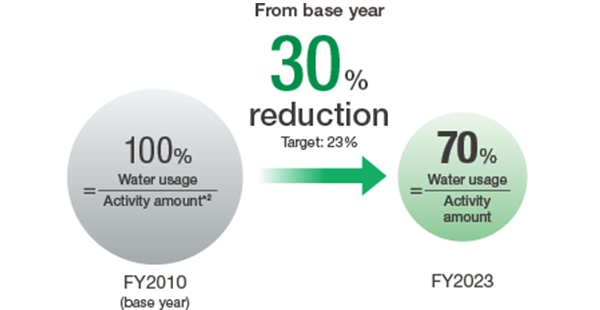
*1Total amount of water used in manufacturing processes and general daily usage at manufacturing sites.
*2Activity amount is a value closely related to water use at each business site (for example, output, sales, and production weight).
Water Usage*1 (Hitachi Group)
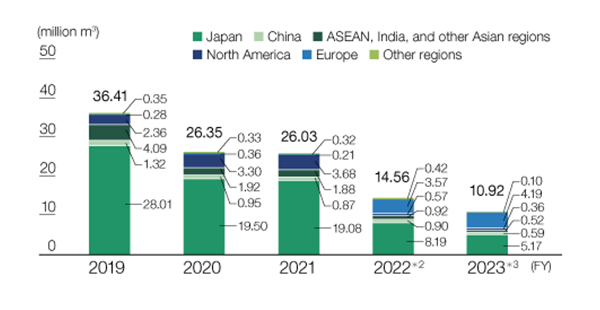
*1Total volume of water used in manufacturing processes and general daily usage at manufacturing sites and in general daily usage at locations other than manufacturing sites.
*2In fiscal 2022, the water usage of an energy-related company and auto parts-related companies included in the scope of consolidation since fiscal 2020 is included in the figures above. The total water usage decreased significantly due to the deconsolidation of the materials- and construction machinery companies.
*3In fiscal 2023, the amount decreased due to the deconsolidation of the auto parts-related companies.
Products and Services that Contribute to Resolving Water Issues
Activities
Hitachi is a comprehensive water services provider that has built a solid track record of experience and expertise in operational technology (OT), products, and services in the sector.
Upgraded Sewage Treatment Plant and Water Reuse Project
Amid global concerns over water scarcity and environmental degradation, Hitachi has contributed to solving social issues related to water and the environment around the world through its Social Innovation Business. In recent years, countries and regions worldwide have encountered various water and environmental challenges, and Hitachi has stepped up to offer tailored solutions to address these needs.
A specific example is the upgraded sewage treatment plant and water reuse project in the Philippines.
This project was awarded to Hitachi by FDC Water Utilities, Inc., which provides water infrastructure facilities. The project aims to transform the Alabang Sewage Treatment Plant (with a processing capacity of 8 million liters per day), situated in Manila, the capital of the Philippines, into an advanced treatment facility using a membrane bioreactor (MBR) system*1 that combines activated sludge treatment with membrane filtration, enabling the removal of nitrogen and phosphorus. The aim is to also increase processing capacity to 15 million liters per day and treat the processed water using a reverse osmosis system*2 and UV disinfection system to produce reclaimed water (at least 10.5 million liters per day) that meets the Philippines’ drinking water standards. For this project, Hitachi not only designed and delivered the mechanical and electrical equipment but also provided digital transformation solutions, including systems for remote plant monitoring and operational optimization. Through this project, Hitachi will help to improve water quality and address increasing water demands in Manila.
*1A membrane bioreactor (MBR) system is a sewage treatment system that combines activated sludge treatment and immersion membranes to enable high-concentration activated sludge treatment. It is easy to maintain, conserves space, is low cost, and ensures high-quality treated water.
*2A reverse osmosis (RO) system is a water purification system that uses pressure higher than osmotic pressure to force water through a semipermeable membrane, resulting in purified water.
Hitachi receives contract for upgraded sewage treatment plant and water reuse projectBasin Flood Control Flood Damage Prediction System
In recent years, the increased frequency and severity of floods in Japan, exacerbated by climate change and other factors, have necessitated local governments to enhance countermeasures. This includes not only physical infrastructure but also software-based approaches utilizing data, such as developing flood hazard maps that encompass smaller rivers.
Hitachi delivered the first basin flood control flood damage prediction system to Aomori Prefecture with full-scale operations commencing from April 2023.
The system incorporates not only mapping data from the Geospatial Information Authority of Japan, but also river data and laser profiler data*1 owned by prefectures to provide high-precision, high-speed flooding simulations. It is also scalable in terms of functionality. For instance, it can aid in evacuations and emergency responses using simulation results, making it effective for enhancing both the physical infrastructure and data-driven strategies in river basin flood control for national and regional governments alike.
More specifically, through the creation of a new, more precise flood risk map (flood frequency map) and an internal water hazard map*2, Hitachi is attempting to develop comprehensive flood risk information encompassing both internal and external waters*3.
In the future, Hitachi plans to deploy this system extensively to municipalities engaged in flood control measures with the aim to reduce damage caused by large-scale floods.
*1Laser profiler data is three-dimensional topographic data obtained by aerial laser surveying
*2An internal water hazard map summarizes estimated data such as flood area and depth when internal water (water flowing through sewers and waterways) floods due to heavy rain or similar events.
*3External water is any water outside of an embankment or river
Operational Start of "Basin Flood Control Flood Damage Prediction System" First Delivered to Aomori PrefectureMoving forward, Hitachi will strive to achieve the Sustainable Development Goals (SDGs) through international cooperation in public-private partnerships that leverage digital technologies. Hitachi will also support the enhancement of social infrastructure with a focus on improving resilience to the growing severity and frequency of climate change-induced disasters.
Water Environment SolutionsHitachi’s Water-related Products and Services
| Activity Field | Products or Services (Implementation to Date) |
|---|---|
| Creating Water Resources | Wastewater recycling systems |
| Seawater desalination systems | |
| Developing Water Infrastructure | Water and sewage treatment, etc. (over 200 sites in about 40 countries and regions) |
| Water purification plants (approximately 700 plants in Japan) |
|
| Sewage treatment plants (approximately 900 plants in Japan) |
|
| Comprehensive digital solutions for water and sewage treatment operators | |
| Integrated Flood Control Measures | Flood forecasting and simulation technology related to evacuations and emergencies |